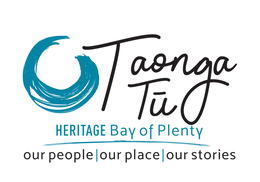Titiro whakamuri, kōkiri whakamura'
'When you understand the past, you know your future'
'When you understand the past, you know your future'
The Eastern Bay of Plenty was one of the first parts of New Zealand to be settled by Māori. The first inhabitant was Tiwakawaka, over 1000 years ago. Tiwakawaka was a grandson of Maui, the legendary voyager and discoverer of Aotearoa.
For some generations, Tiwakawaka’s people lived in Kakahoroa, later named Whakatāne, before the arrival of the tribes Te Tini o Toi, Te Hapuoneone and Nga Potiki. Many of Te Tini o Toi, Toi’s people, formed marriage alliances with the original settlers. High above Whakatāne, Toi’s stronghold was Kapu-te-rangi, one of the oldest known pa sites in New Zealand. Toi’s sons Rauru and Awanuiarangi founded tribes of their own.
Awanuiarangi is considered the founding ancestor of the Ngāti Awa iwi, whose rohe includes much of the lowland part of the present-day Whakatāne District, including Whakatāne township. Ngāti Awa, Ngāi Tuhoe and Whakatōhea, the principal tribes of the Eastern Bay of Plenty, stem from the Mataatua waka (canoe), which also landed in Kakahoroa after its journey across the Pacific from Hawaiki. Again, the voyagers formed alliances with the people they found here, their descendants eventually peopling much of the North Island’s eastern coastline and hinterland.
European settlement began in the 1830s, when whalers, sealers and later missionaries and traders made their homes here. The area became a major shipbuilding centre. The ships were used to carry maize, potatoes, wheat and flax to other northern population centres.
While many Eastern Bay of Plenty Māori took no active part, the area became embroiled in the New Zealand land wars of the 1860s-1870s. In 1866, the government confiscated 181,000 hectares of land belonging to Ngāi Tūhoe, Te Whakatōhea and Ngāti Awa.
Between 1911 and 1925, the Rangitāiki Plains wetland was drained, enabling widespread farmland development. Reclamation in Whakatāne also created new land for residential and commercial use.
In the 1950s, the towns of Kawerau and Murupara were developed to serve the forestry industry. Near Kawerau, a pulp, paper and timber mill was opened to process timber from Kaingaroa Forest. Murupara housed forestry workers and was the railhead for logs going to the Kawerau mill.
to edit.
Source Whakatane District Council
HOME
ABOUT: Our Team | Ōtamataha Pā | Taonga - our treasure | Our brand story
WHATS ON: Exhibitions | Past Events | Videos
DISCOVER: Our Tāngata whenua | Early Tauranga | Waihi Beach | Katikati | Mauao - the legend | The Kaituna | Te Puke | Maketu - magic
OUR HERITAGE: Heritage Collection | Heritage Gallery | Battles of Gate Pā & Te Ranga | The Apology | St George's Gate Pā | The Elms |
Historical Society | Tauranga Jazz Festival History | Maori Proverbs | Heritage Organisations | Archives | The Golden Years
HERITAGE FRIENDS
CONTACT
ABOUT: Our Team | Ōtamataha Pā | Taonga - our treasure | Our brand story
WHATS ON: Exhibitions | Past Events | Videos
DISCOVER: Our Tāngata whenua | Early Tauranga | Waihi Beach | Katikati | Mauao - the legend | The Kaituna | Te Puke | Maketu - magic
OUR HERITAGE: Heritage Collection | Heritage Gallery | Battles of Gate Pā & Te Ranga | The Apology | St George's Gate Pā | The Elms |
Historical Society | Tauranga Jazz Festival History | Maori Proverbs | Heritage Organisations | Archives | The Golden Years
HERITAGE FRIENDS
CONTACT
Content Copyright Organic Living Ltd © 2022


